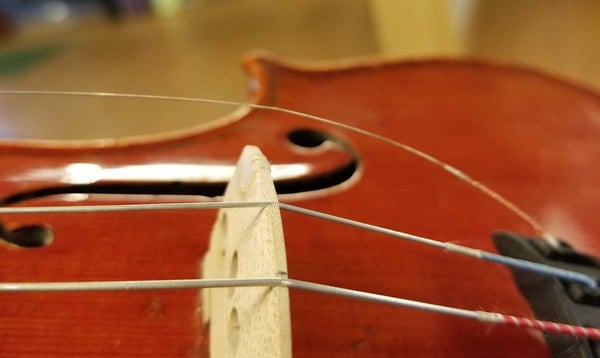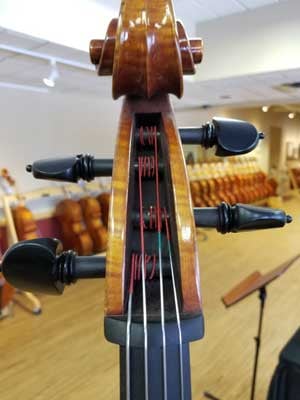
It's a scenario every beginner or intermediate string player finds themselves in at some point: either a string broke, the metal winding is unraveling, or they've simply decided better strings will make them finally sound like Anne-Sophie Mutter. I can tune my strings by now; I'm sure changing my strings is simple enough! With headstrong independence they place an order for the set they heard are really great and wait patiently for their new strings to arrive. In a few days, they tear open the package, sit down with their instrument and get started...
Most professional players would cringe if they could look back on themselves the first time they changed their strings on their own. It really is a skill, like playing the instrument, that you become better at and more comfortable with over time and with proper instruction. There are very common beginner mistakes, some I myself was guilty of, that can have consequences ranging from minor frustration to the soul-crushing dismay of a brand new $50 string snapping in your face. Here are a few common errors that you should avoid if this is your first time changing strings on your own. Hint: If it is your first time - ask for guidance pertaining to how to restring a violin, violin strings order, or other string replacement aspects of other stringed instruments from a teacher, instrument technician/luthier, or experienced player.
Mistake #1: Not placing the strings in the proper order.

When replacing the strings of any instrument, it’s important to know whether there is a specific order in which they should be placed. And if there is one, what is it? For instance a violin strings order is different from a guitar strings order. Guitar strings go from low E, A, D, G, and B to a high E. However since violins are completely different from guitars, which are fingered instruments, the violin string order differs to a considerable extent. The proper order for the strings of a violin is: low to high - G, D, A, and then E. No matter what stringed instrument you’re working with, find out the right strings order for it.
Mistake #2: Removing more than one string at a time.
One of the most important aspects to learn about “How to change violin strings” is: On a four-stringed instrument like violins, violas, cellos, and basses, there should never be less than three strings on it at one time. This means you only change one string at a time, starting by replacing any broken strings. It's also helpful to keep the other three strings roughly in tune. The reason is that the bridge and/or soundpost can fall if there isn't sufficient string tension on the instrument. If the soundpost falls, you will have to take the instrument to a shop or luthier to have it corrected. Even if only the bridge falls or shifts and you don't know exactly the position it should be in, you are best off taking it to a professional to have them remedy the situation. It's also important to make sure the bridge remains straight during the whole process for this reason - tightening at the pegs can cause the bridge to lean and even fall, slapping down on the instrument.
Mistake #3: Winding the string the wrong way around the peg.
Besides the right violin strings order, it’s crucial to know how to properly wind a string around a peg. In fact properly winding a string around a peg is the second highest form of art that can be made with a stringed instrument second to playing the dang thing. First timers are usually terrible at it, but a few pointers will get you started on the right track. First of all, the string must always wrap over the peg. This isn't some sort of debate like which way to hang toiletpaper on the roller - the string must tighten when the peg is turned "away" from the fingerboard! This is true because of the angle and curvature of the nut, and the way that it reduces friction by reducing incident force. Secondly, the string should be inserted just to the end of the hole in the peg, wound once on the opposite side, then crossed over itself before being wound in close-together-loops and ending directly in line with its corresponding groove in the nut. Lastly (take special note, cellists, as this has broken more cello strings than bartok pizz and Rostopovich combined), you should avoid letting the string rub or get pinched by the inside surface of the pegbox. The string is especially prone to break if the string comes into contact with the wall of the pegbox just as it is reaching pitch. Avoid this by pulling the peg out slightly to keep the windings very close together.
Here is a video that illustrates proper string-changing technique:
Mistake #4: Buying the wrong strings.
Now that you know the proper violin strings order, how to wind the string the right way around the peg, and that only one string should be changed at a time, it makes sense to gather information about what strings to order when restringing a violin. Similarly, when looking up information on “How to string a cello”, it’s important to know what the cello string notes are and what strings to buy. No matter what type of stringed instrument you’re restringing, knowing what strings to buy would save you significant resources. Read and re-read the description of the strings you are buying. Does it say violin or viola (okay, why aren't we all calling the viola "bratsch" by now - that would really reduce confusion)? Is it medium gauge, or did you want to try a heavy or light gauge? Does your violin or viola require the highest string to be loop or ball, and what comes with the set? Are these really the authentic brandname strings you will get, or could you be buying grey market or counterfeit strings from an online marketplace? Are they the correct size? This is especially tricky for violists, for whom "full size" can mean just about anything. Still violinists, cellists, and bassists can overlook that they're buying a fractional set when their eyes catch that fractional price... Speaking of bassists, are you sure that's not a solo-tuning A or E string?
Mistake #5: Overtightening the string.
Overtightening the string can be as detrimental to your practice as would be placing the strings in the incorrect violin strings order. No matter what type of stringed instrument you’re restringing or no matter what anyone says, never tune your string above the pitch it is meant to be tuned to. Your strings will "stretch" just fine by tuning them to pitch and playing on them for a day or two. All you're doing by over-tightening them is jeopardizing the instrument and your brand new strings (at the very least reducing their elasticity, which you want for good tone and tuning stability). Ideally, you should just tune the new strings up to pitch and continuously tune all of the other strings to pitch to keep the instrument's tensions in balance as you change strings one at a time.
 Mistake #6: Throwing away your old strings.
Mistake #6: Throwing away your old strings.
Old strings make great backups that are already "stretched-out" for when you have to replace a broken string immediately before or mid-performance. Put them back in the string envelopes and mark the date removed so you know how long they were on the instrument.
Mistake #7: Missing the opportunity to change parts, clean the instrument, or have setup work done.
We now know the importance of knowing what strings to buy or the proper violin strings order or the ideal order of strings in whichever instrument you’re restringing. But did you know that restringing an instrument provides the perfect opportunity to fine-tune or simply clean it? Maybe you've been considering changing the fine-tuner setup, or getting a new tailpiece. Perhaps it's time to have your fingerboard planed as grooves are starting to form under the strings. Perhaps it's time to have your fingerboard planed as grooves are starting to form under the strings. Maybe you just need to finally clean the oil and dust from under the strings. In any case, it might just be worth bringing your strings to an instrument tech or luthier to have them do some additional work on the instrument, and let them put the new strings on when they are done. If you are changing the strings yourself, now is the time to apply peg compound, clean under the strings, lubricate the nut with graphite, or add/remove fine tuners. Maybe treat yourself to a Luxitune fine tuner with gemstones in it?
Here's a favorite video of proper string installation by a SHAR Apprentice:
Editors note: Doing any work on a stringed instrument, including changing strings, should only be done by a sufficiently trained individual or under their supervision. SHAR does not take responsibility for injury or damage done to strings or an instrument due to using this blog for reference, and the opinions of the author do not necessarily represent those of SHAR or its affiliates.
Thank you for reading! For weekly or monthly informational blogs like this one direct to your email, as well as product reviews, string instrument news, and fun contests, and more, put your email in the "subscribe" box on this page! You can also find SHAR on facebook, instagram, and twitter!



